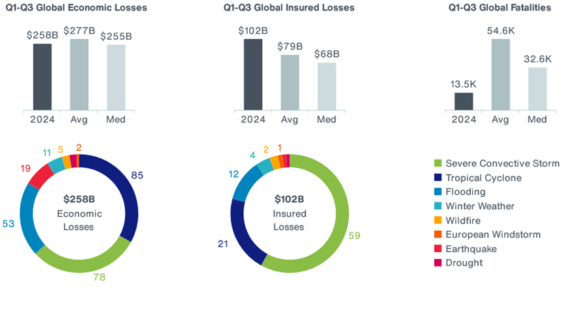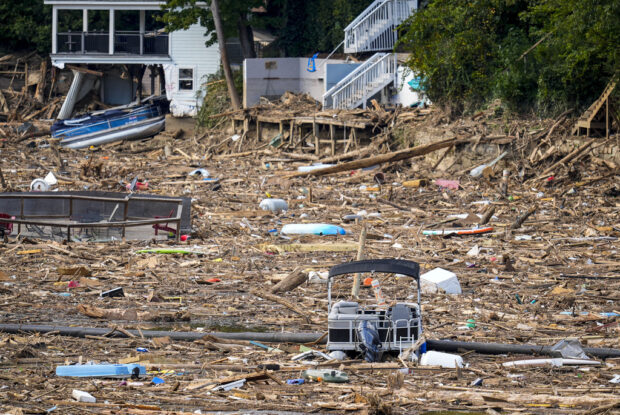The third quarter of 2024 saw a significant number of natural disaster events, which drove year-to-date economic losses above at least $258 billion and insured losses of at least $102 billion, according to Aon plc in its Q3 Global Catastrophe Recap – October 2024 report, which aggregates and analyzes global natural catastrophe data.
The report reveals that there were at least 280 notable global natural disaster events in the Q1-Q3 period. Losses from Hurricane Milton and additional events expected in the rest of the calendar year, however, will likely push total annual insured losses above those seen in 2023 ($125 billion), Aon said.
Economic losses for the first nine months were significantly lower than losses during the same period in 2023 ($351 billion).
Third-quarter insured losses were driven by three costly Atlantic hurricanes (Helene, Beryl and Debby), severe convective storm (SCS) outbreaks in the United States and Canada, as well as flooding in Central Europe.
These dynamics resulted in a protection gap of 60 percent—one of the lowest on record—mainly due to the higher contribution of insured losses in the United States, where insurance penetration is relatively high compared to other countries, Aon said.
The report highlights that insured losses from primary perils during the first nine months of 2024 were relatively low, with no event exhibiting the potential to significantly affect the broader reinsurance market.
“Most of the losses, including those from SCS as the costliest peril overall, continued to be retained by insurers in Q3, prolonging the period of exceptional returns for reinsurers,” the report added.
Global reinsurer capital neared $700 billion as of June 30, Aon estimated, noting that this figure is forecast to grow into 2025, provided no substantial catastrophic events will reverse this trend.

Additional findings from the report include:
- The U.S. has seen 26 separate billion-dollar natural catastrophe events this year. The U.S. accounted for nearly 80 percent of global insured losses in the first three quarters of 2024, reaching nearly $80 billion.
- The global insured loss total was expected to reach at least $102 billion by the end of September, well above the 21st century average of $79 billion.
- Global economic losses (which include insured loss totals) due to natural disasters in the Q1–Q3 period of 2024 were preliminarily estimated at $258 billion, approximately 7 percent lower than the long-term mean since 2000 ($277 billion), and slightly above the median ($254 billion).
- Hurricane Helene is by far the costliest event of the Q1-Q3 period, with preliminary economic loss totals of $55 billion in the U.S., Mexico and Cuba and insured losses still being assessed. Losses from Hurricane Milton (a Q4 event) are still being assessed.
- Canada is enduring its costliest insurance loss year on record, with most of the impact occurring as a result of four events within one month in Q3, with expected payouts exceeding $5.5 billion. These events were flash flooding across southern Ontario in mid-July, the Jasper Fire in Alberta, as well as the Calgary Hailstorm and remnants of Hurricane Debby that both caused extensive damage in early August.
- The number of billion-dollar events during Q1-Q3 was 47, 32 of which occurred in North America, eight in Asia, four in EMEA, and three in South America. (Note: this analysis does not include Hurricane Milton.)
- Typhoon Yagi became the third costliest event of 2024 so far with economic losses of at least $12.6 billion – the majority reported from China. Additionally, Yagi was the costliest event to hit Vietnam on record, generating at least 81.5 trillion Vietnamese Dong ($3.3 billion) in economic losses, according to governmental estimates.
- The total number of fatalities from natural disasters across the globe to the end of Q3 was estimated at around 13,000 – the lowest since 1986.
“Our latest study highlights the complexity of natural catastrophe risk management for organisations, necessitating a myriad of resources around physical measures, warning systems, forecasts, and public awareness,” commented Michal Lorinc, head of catastrophe insight at Aon. “The insurance industry has again played a significant role in this process, with re/insurance covering a high proportion of the global losses so far this year relative to previous periods.”
Source: Aon
Photograph: Debris is strewn on the lake in the aftermath of Hurricane Helene, Wednesday, Oct. 2, 2024, in Lake Lure, North Carolina. (AP Photo/Mike Stewart)





















 Bankers Readying U.S. IPOs at ‘Overwhelming’ Pace Ahead of 2026
Bankers Readying U.S. IPOs at ‘Overwhelming’ Pace Ahead of 2026  Executives on the Move at HSB, American Modern Insurance Group, AIG
Executives on the Move at HSB, American Modern Insurance Group, AIG  Examining 5 Key Factors Fueling MGA Growth—and Emerging Challenges Ahead
Examining 5 Key Factors Fueling MGA Growth—and Emerging Challenges Ahead  Aon Adds to List of Brokers Suing Howden US for Alleged Poaching, Theft
Aon Adds to List of Brokers Suing Howden US for Alleged Poaching, Theft 